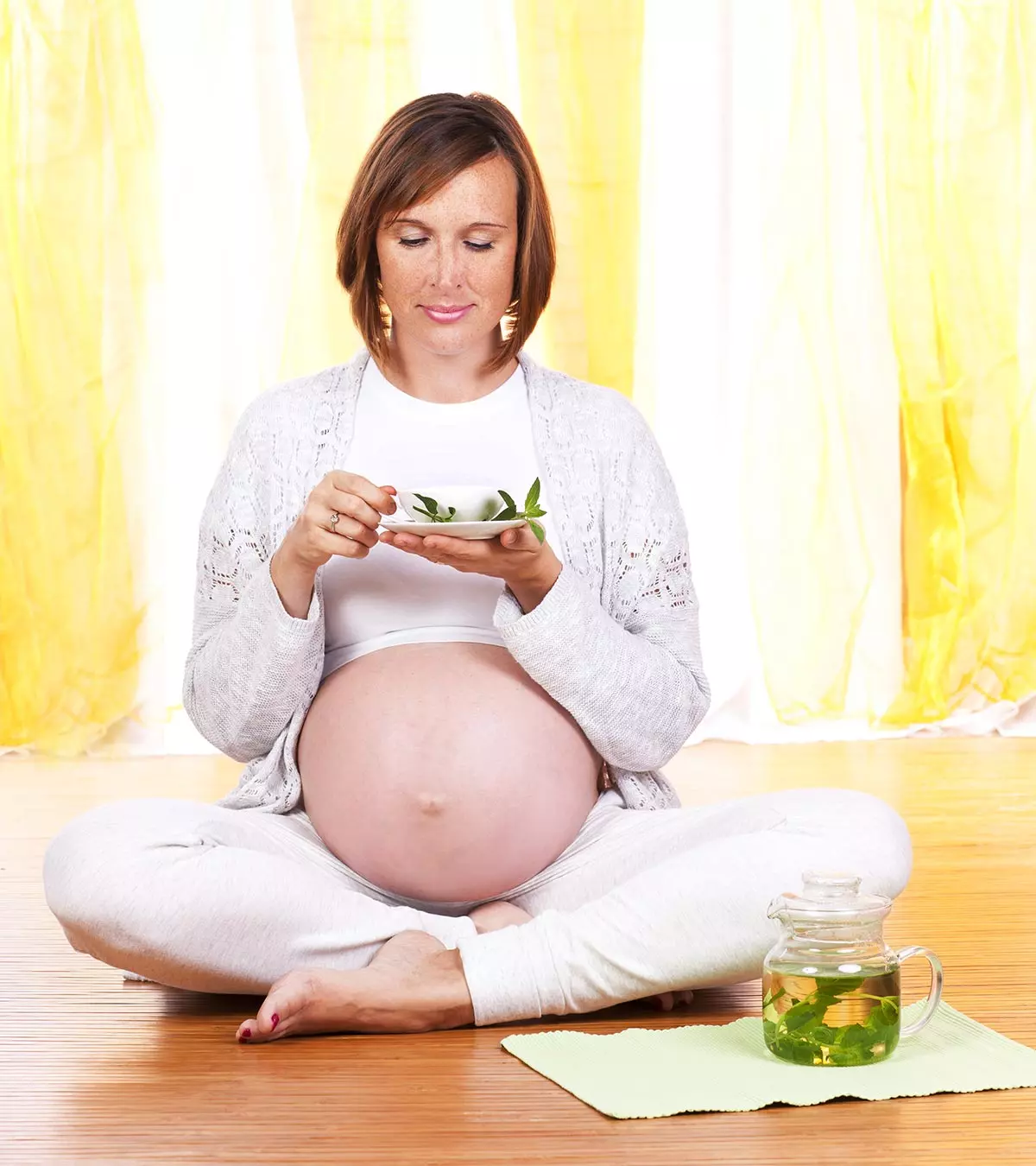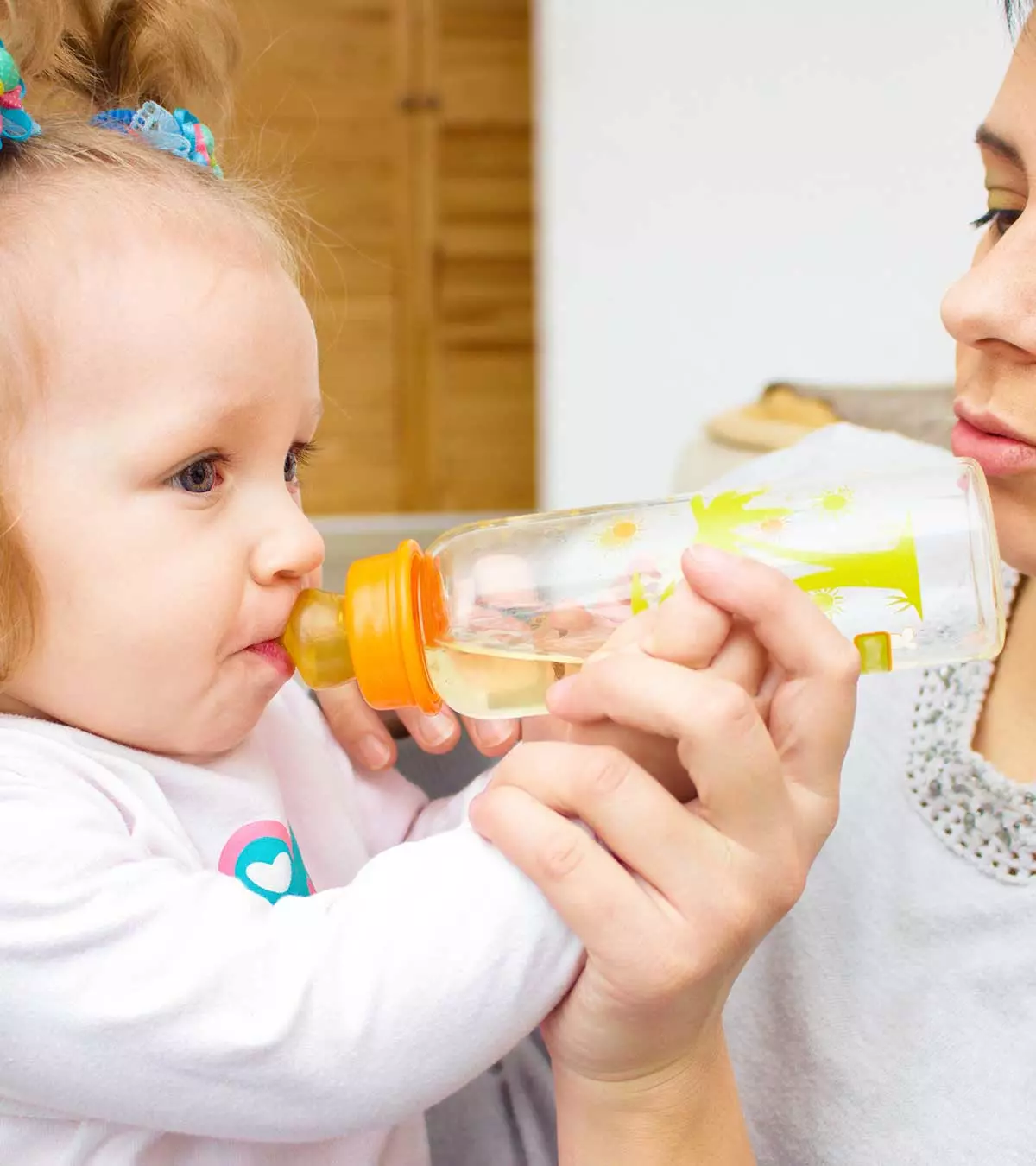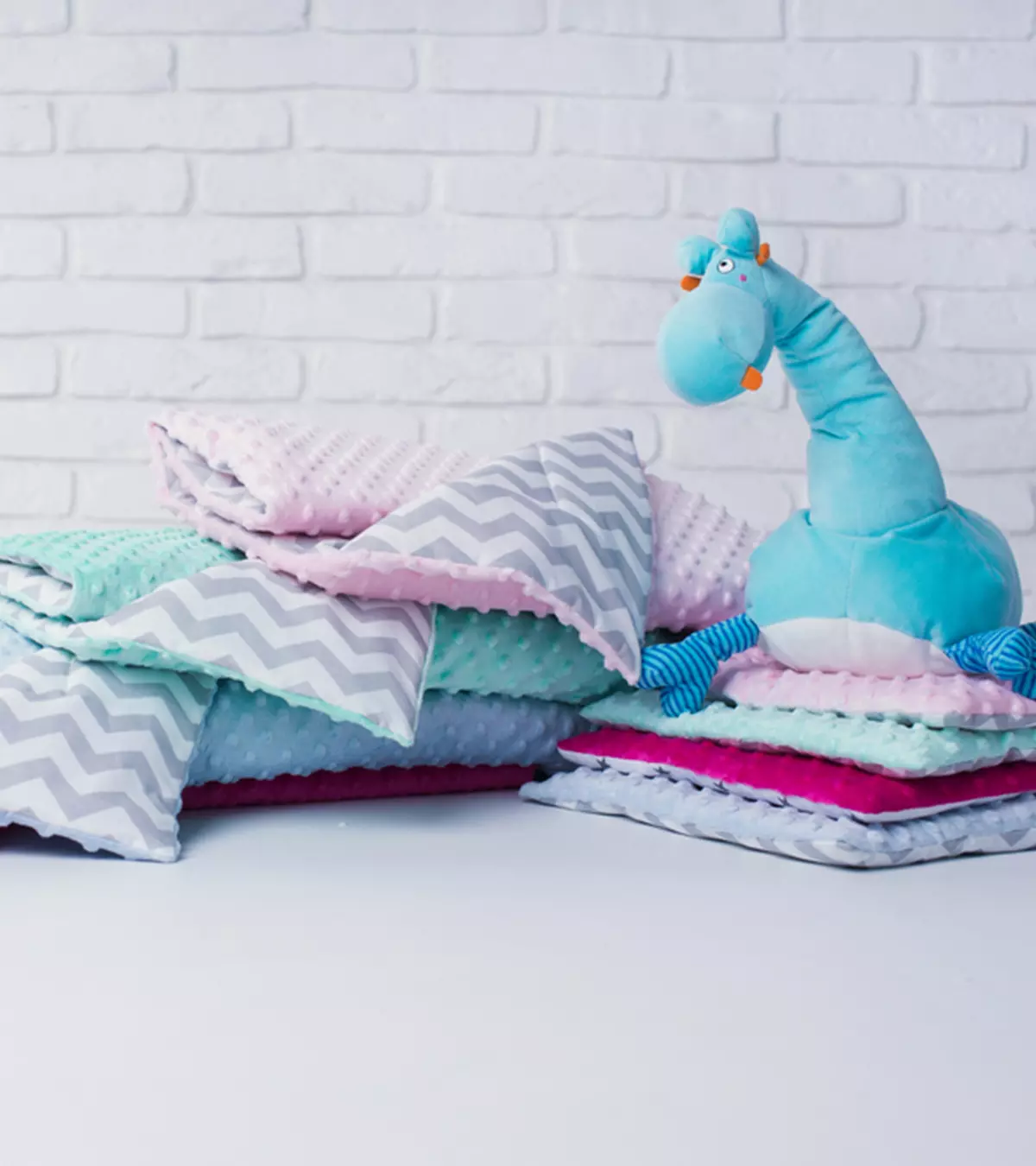
Image: Shutterstock
A baby blanket is a popular gift for infants since it is useful and keeps them warm and comfy. However, with several sizes available in the market, how do you pick out the right size of a baby blanket. Blankets that are too big or small might be uncomfortable for babies. When covering your baby with a blanket, it is essential to keep some safety precautions in mind. For example, blankets are not suggested for babies under 12 months due to the significant risk of sudden infant death syndrome (SIDS) among babies belonging to this age group. Babies belonging to one to three months of age are the most vulnerable to suffocation (1).
Read on to know when babies can sleep in a blanket, the best size and materials for a blanket, the types of baby blankets available in the market, and the basic blanket safety rules.
Key Pointers
- Choosing the right blanket for your baby is important to keep them comfortable in all conditions.
- Blankets made of natural fabrics such as cotton are ideal for babies. However, pick one made of soft wool for colder environments.
- A cozy swaddle blanket or versatile multi-use blanket comes in handy for travel purposes.
- You can also make a customized blanket by following the simple steps we have listed in the post.
When Can Babies Sleep With A Blanket?
To safely introduce a blanket, your little one must fulfill two main criteria (1):
- The baby is one-year-old
- The baby is able to roll over and has complete control of its head
Introducing a pillow to your baby should also be done at the same time when you introduce a blanket to them.
Why Is It Important To Pick The Right Size Blanket For Your Baby?
Appropriate sizing of a blanket is critical. A smaller blanket can make the baby feel cold in the middle of the night, and a larger than the required size blanket has its risks.
- You should not use large, loose blankets near your baby. There is a chance that your baby can pull the blanket over their face and get suffocated (2).
- Having a large blanket for your baby also impedes their movements and causes them to wriggle underneath the sheets (3).
Basic Blanket Safety Rules You Must Follow For Your Baby
Although using a blanket may seem routine for adults, it is essential to follow certain guidelines when using it for a baby, as with any other baby product.
Here are some basic blanket rules that you must follow for your baby:
- Always use the right blanket size for your baby, ensuring the blanket is not too big.
- Use natural blanket materials such as organic cotton as they are gentle and more breathable (3).
- Use fitted blankets that are not loose or come off easily—to avoid your baby pulling them over their heads during their sleep (4).
- Avoid soft infant bedding, mattresses, or blankets during zero to 12 months of your baby’s life.
- Always tuck in your baby’s blanket, not higher than their shoulders (5).
- Newborns and infants less than one year of age must never use blankets since it increases the risk of SIDS (Sudden Infant Death Syndrome) and suffocation (6).
 Caution
CautionWhat Is The Best Size For A Baby Blanket?
There are blanket size charts easily available, but since every baby is different, there can’t be a one-size-fits-all blanket for babies of a certain age.
The best size for your baby’s blanket should be:
- Big enough to cover them well but not too big to cause them to wriggle under it.
- Your baby should be able to use it for a few months.
- It shouldn’t be too big that it is difficult to roll or carry during travel.
Each type of blanket has a particular size and dimensions to serve its purpose
. For example, swaddling blankets are square, while crib blankets should fit snugly when tucked under the crib mattress.
The Ideal Material For Baby Blankets
Finding the perfect blanket for your baby includes understanding the best material.
- Use natural, breathable materials that allow airflow and your baby to lose heat when their body cools down (3).
- A cellular cotton blanket is an ideal choice for your baby as it keeps your baby warm and allows airflow to regulate their body temperature. And with the holes in it by design, it is safe even if your baby accidentally pulls it over their face (3).
- At the same time, one must avoid fleece and sheepskin blankets as they cause your baby’s body to heat up.
- The ideal material for baby blankets in cold weather is soft-wool cashmere or angora wool. Use a thin blanket in summers and a slightly thicker one for the winter. Avoid synthetic and rough materials such as polyester for your baby’s blanket.
Even with an ideal material blanket for your baby, try not to fold it as it counts as two blankets, which can heat your baby‘s body. The blanket you choose must be able to maintain an ambient temperature for your baby—giving them a good night’s sleep and keeping them safe at the same time.
Types of Baby Blankets
There are different blanket types available in the market today that are considered baby essentials, and each one has a specific purpose, apart from keeping your baby warm and safe.
1. Swaddle Blanket

Image: Shutterstock
Most newborns love to be swaddled as it mimics the warmth and tightness of their mother’s womb. A swaddle blanket can be rectangular or square-shaped and requires a diamond shape technique to swaddle the baby (7). Take care while wrapping your baby such that their hips and legs are free to move. Also, remember that some babies may not like to be swaddled and in such cases, avoid swaddling them.
2. Preemie Blanket
Premature babies need additional love, care, and time to catch up with their full-term counterparts. Blankets are essential for these babies because they keep them warm and regulate their body temperature. These blankets come in different sizes for small and large preemie babies and can be used in a pram or stroller, bassinet, and crib.
3. Receiving Blanket

Image: Shutterstock
It is a multifunctional blanket. A receiving blanket is lightweight, simple in design, and can be used for various functions such as swaddling your baby, laying your baby down on the floor at home or on an unfamiliar surface, catching spit or drool, and feeding.
4. Crib Blanket
As the name goes, these blankets are used to keep your baby warm in a crib. They are functional and come in many different patterns, designs, and materials. However, while picking the right crib blanket for your little one, consider your baby’s age and size, the weather in your place, and the crib’s size.
5. Security Blanket
Security blankets are a must-have in your baby merchandise collection. These blankets are smaller than receiving blankets and are helpful to bring your baby home from the hospital or carry around in the house. They are made of thin material, which is durable and easy to wash.
6. Multi-Use Blanket
Multi-use blankets are ideal baby shower gifts for a mother-to-be. They are versatile and can be used as receiving blankets, pram, bassinet blankets, travel blankets, or as the need may be. They come in various sizes and can be used even as the little one grows.
7. Afghan Blanket
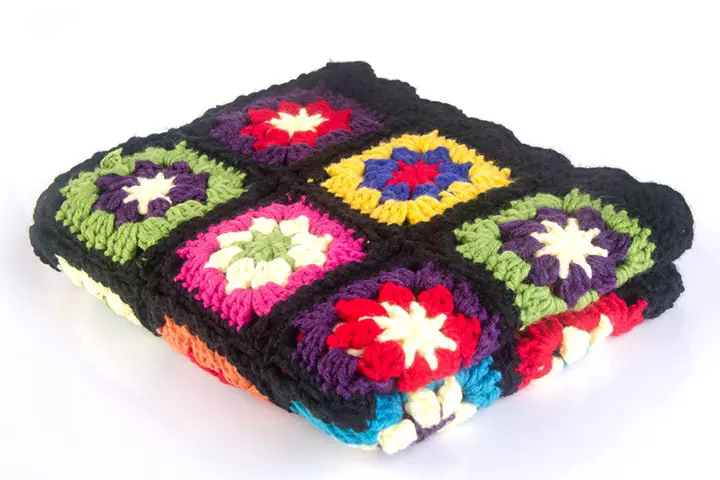
Image: Shutterstock
These blankets come in colorful designs and a variety of sizes. These blankets are safe for babies who are able to hold their heads with no risk of suffocation and are a great choice for toddlers.
8. Newborn Baby Blankets
Ideal for newborns, these come in a standard 30×30 inches size.
DIY Baby Blanket
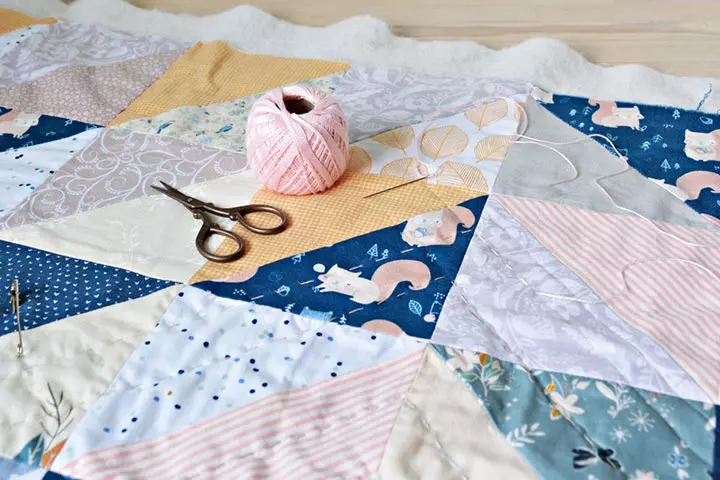
Image: Shutterstock
It is easy and quick to create a cozy baby blanket, either for your own little one or as a thoughtful present for soon-to-be parents to complement their nursery accessories. All you need to make a baby blanket are:
- Two pieces of your choice of baby blanket material
- A color-coordinated thread to stitch the blanket pieces
- Sewing machine
Steps to make the blanket:
- Straighten up the two cloth pieces with an iron and make sure the pieces are of the same size.
- Place one piece on top of the other and use pins to hold them in place.
- Using the pins as a guideline, stitch the sides with a thread and needle or take the help of a sewing machine.
- Leave around 7-8 inches of the blanket unsewn and cut off the four corners without cutting the thread.
- Turn the blanket inside out and use a crochet stick to poke out the corners.
- Use a decorative stitch to finish the opening of the blanket.
- Use zig-zag stitches at random places along the blanket to maintain its shape when washed.
Your home-made, comfortable baby blanket is ready.
 Quick tip
Quick tipHow To Wrap A Newborn In A Blanket?
Wrapping a newborn baby in a blanket, also known as swaddling, is a practice that can provide comfort and security to the infant. Here’s a step-by-step guide (8) (9):
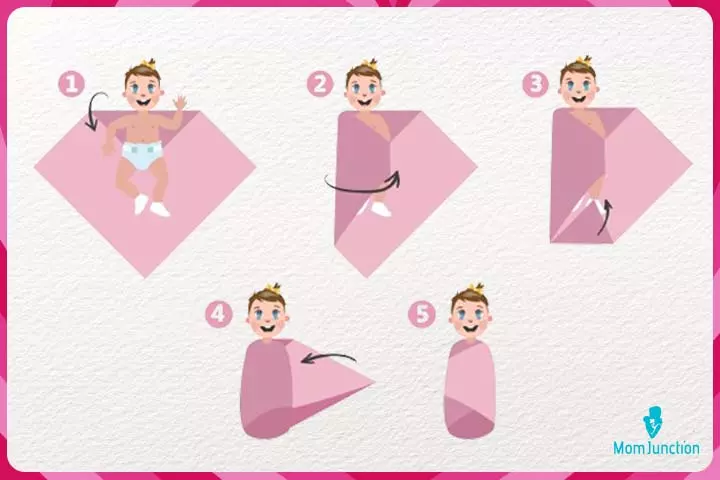
- Lay the blanket on a flat surface in a diamond shape, with the top corner folded down. Position the baby with their head slightly above the folded top corner of the blanket, ensuring their shoulders are aligned with the upper edge.
- Fold the left or right corner of the blanket over the baby’s arm, tucking it snugly under the opposite side of the body. Leave the other arm free.
- Lift the bottom corner of the blanket and fold it up over the baby’s legs, tucking it under the baby’s legs.
- Fold the other corner of the blanket over the free arm and tuck it under the baby’s body, on the opposite side.
- Ensure that the swaddle is not too tight, allowing the baby’s hips to move freely.
Swaddling can mimic the womb environment, promoting better sleep and soothing the newborn. However, it’s important to follow safe swaddling practices. Always lay the swaddled baby on their back to reduce the risk of Sudden Infant Death Syndrome (SIDS). Hence, consult with your pediatrician for personalized advice.
Frequently Asked Questions
1. Why do babies smell their blankets?
Babies may smell their blankets for the familiar scents such as breast milk or baby lotion to soothe and comfort themselves (10).
2. Do newborns always need a blanket?
No, newborns do not need a blanket. However, you may use tightly wrapped blankets to swaddle them in the first few weeks of life (11) (12). While choosing a blanket keep its measurements, such as length and width, in consideration to ensure safe and secure swaddling.
3. When should I stop using a baby blanket?
After your baby crosses the one-year mark, you may pick a suitable blanket per your baby’s height and the prevailing weather conditions. However, you may have to regularly replace the blankets if your baby or toddler has outgrown its size.
Using blankets is not recommended for babies younger than a year. The size of the baby blanket is also crucial as a larger one may completely cover the baby and cause suffocation and increased risk of sudden infant death syndrome (SIDS). Fitted blankets made of soft and breathable material are preferable. In addition, they must provide a comfortable temperature and not overheat the baby. Different types of blankets, such as crib blankets, receiving blankets, and swaddle blankets, serve different purposes and are shaped and sized accordingly. You may also make a blanket for your little one or as a gift for new parents, which will be a memorable baby keepsake.
Infographic: Baby Blanket Safety Tips
Having a newborn at home entails being careful with everything, including bedding and blankets. There is a lot of safety advice on using blankets for babies. Check out the following infographic to know the rules for the safe use of baby blankets.

Illustration: Momjunction Design Team
Illustration: How To Pick The Right Baby Blanket Size & Why It Is Important
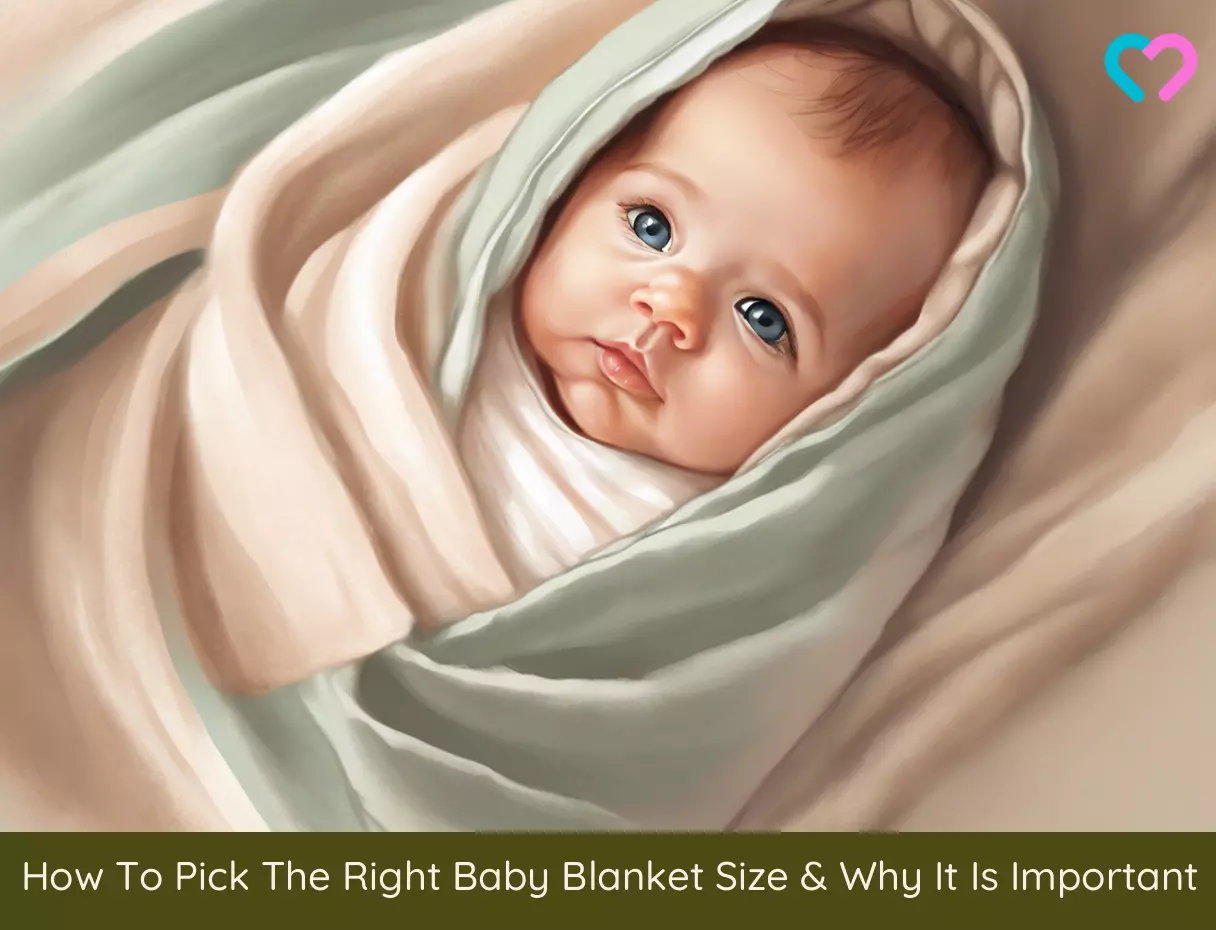
Image: Stable Diffusion/MomJunction Design Team
The baby blanket helps keep the baby warm and safe, but using the right blanket is essential for optimal use. This video will show you how to make the easiest and softest baby blanket ever!
References
1. Kelli Anderson, When Should I Introduce a Baby Blanket, Children’s Hospital Los Angeles
2. Helping Babies Sleep Safely, Centers for Disease Control and Prevention
3. Feet to Foot and tuck me in with blankets under my arms, Safe Sleep Scotland
4. Safe Sleeping: 11 Tips, Raising Children Australia
5. Safe Sleep for Babies, Pregnancy Birth & Baby
6. Weighted Blankets, Children’s MD (Feb 2015)
7. How and When to Swaddle Your Baby, Intermountain Healthcare
8. The Right Way To Wrap; St. Louis Children’s Hospital
9. Swaddling: Is it Safe for Your Baby?; American Academy of Pediatrics
10. Smell, Taste, and Nutrition: Building Blocks for Early Brain Development, The Urban Child Institute
11. Sleep in Infants (2-12 Months), Nationwide Children’s
12. Swaddling a baby: the benefits, risks and seven safety tips, National Childbirth Trust
13. Weighted blankets are not safe for babies, Red Nose Australia
Community Experiences
Join the conversation and become a part of our nurturing community! Share your stories, experiences, and insights to connect with fellow parents.
Read full bio of Kay Lakka
Read full bio of Rohit Garoo
Read full bio of Dr. Ritika Shah
Read full bio of Vidya Tadapatri













